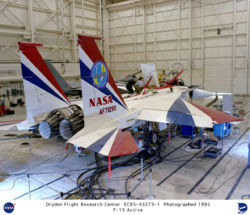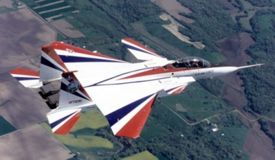PlaneSpottingWorld welcomes all new members! Please gives your ideas at the Terminal.
F-15 S/MTD
| F-15 S/MTD | |
|---|---|
| Type | Technology Demonstrator and Research Aircraft |
| Manufacturer | McDonnell Douglas |
| Maiden flight | 1988-09-07 |
| Retired | 1991-08-12 |
| Primary users | United States Air Force NASA |
| Developed from | F-15 Eagle |
The McDonnell Douglas F-15 S/MTD (Short Takeoff and Landing/Maneuver Technology Demonstrator) is a modified F-15 Eagle. Developed as a technology demonstrator, the F-15 S/MTD carried out research for studying the effects of vectored thrust and enhanced maneuverability. The aircraft used for the project was pre-production TF-15A (F-15B) #1 (USAF S/N 71-0290), the first delivered F-15 airframe, which is on loan to NASA from the United States Air Force.
This same aircraft would later be used in the F-15 ACTIVE (Advanced Control Technology for Integrated Vehicles) from 1993-1999, and later in the Intelligent Flight Control System programs from 1999 on. With the help of thrust vectoring nozzles, this aircraft can perform the famous Pugachev's Cobra maneuver.
Contents
Profile
The aircraft used in the S/MTD program has flown several times since the successful S/MTD program completion in 1991 that used vectored thrust and canard foreplanes to improve low-speed performance. This aircraft tested high-tech methods for operating from a short runway — important during wartime, when airfields are likely to be attacked and cratered by enemy fire. This F-15 was part of an effort to improve ABO (Air Base Operability), the survival of warplanes and fighting capability at airfields under attack. A variety of measures — point defenses, construction decoys (such as ones used during World War II), and other deceptions — give airfields high likelihood of remaining in use in the midst of a shooting war.
The F-15 S/MTD tested ways to improve the situation by demonstrating the ability to land and take off from wet, bomb-damaged runways. The aircraft used a combination of reversible engine thrust, jet nozzles that could be deflected by 20 degrees, and canard foreplanes. Pitch vectoring/reversing nozzles and canard foreplanes were fitted to the F-15 in 1988. NASA acquired the plane in 1993 and replaced the engines with Pratt & Whitney F100-229 engines with Pitch/Yaw vectoring nozzles. [1] The canard foreplanes were derived from the F/A-18's stabilator.
Prior to the 1991, when McDonnell Douglas ended its program after accomplishing their flight objectives, the F-15 STOL/MTD plane achieved some impressive performance results:[2]
- vectored takeoffs with rotation demonstrated at speeds as low as 42 mph
- a 25-percent reduction in takeoff roll
- landing on just 1,650 ft of runway compared to 7,500 ft for the standard F-15
- thrust reversal in flight to produce rapid decelerations
- controlled flight at angles of attack up to about 85 deg without vertical-tail surfaces
How the S/MTD works
- Nozzles: By using a combination of the movable nozzles and vanes in the jet pipe, the S/MTD can direct gas forward, outward or at an angle of up to 20 degrees to the axis of the aircraft.
- Combined effect: With its highly advanced flight control software, the S/MTD coordinates the movement of the forward canards to give up-force, and the tailplanes and nozzles produce a down-force when maneuvering.
- Fast Stop: By vectoring engine gas from above and below the nozzles and turning the canard foreplanes to act as giant airbrakes, the S/MTD could decelerate very rapidly (and unlike the Hawker Siddeley Harrier and its family, the powerful F100 engine allows it to accelerate again just as rapidly). This kind of maneuver might be useful in a dogfight.
Further modifications
This same aircraft would later be used in the F-15 ACTIVE (Advanced Control Technology for Integrated Vehicles) program from 1993-1999
The aircraft would later be used in the F-15 IFCS (Intelligent Flight Control System) program from 1999.
Specifications (F-15 S/MTD)
General characteristics
- Crew: Two
- Length: 64 ft (19.7 m)
- Wingspan: 42.8 ft (13 m)
- Height: 18 ft 6 in (5.64 m)
- Wing area: 626 ft² (58.2 m²)
- Empty weight: 26,966 lb (12,232 kg)
- Loaded weight: 44,442 lb (20,159 kg)
- Max takeoff weight: 70,400 lb (31,930 kg)
- Powerplant: 2× Pratt & Whitney F100-PW-200 turbofan engines, equipped with Pratt & Whitney 20 Degree two-dimensional thrust vectoring nozzles, reverse thrust capable
- Dry thrust: 14,360 lbf (63.88 kN) each
- Thrust with afterburner: 23,780 lbf (105.78 kN) each
Performance
- Maximum speed: Mach 2.1 at 37,650 ft (1,650 mph / 2,650 km/h at 11,500 m)
- Range: 2,737 mi (4,405 km)
- Service ceiling: 58,220 ft (17,750 m)
Specifications (F-15 ACTIVE)

General characteristics
- Crew: two
- Length: 63.7 ft excluding flight test nose boom (19.42 m)
- Wingspan: 42.8 ft (13 m)
- Height: 18 ft 6 in (5.64 m)
- Empty weight: 35,000 lb (15,876 kg)
- Loaded weight: 47,000 lb (21,319 kg)
- Powerplant: 2× Pratt & Whitney F100-PW-299 turbofan engines, equipped with Pratt & Whitney P/YBBN 20 Degree three-dimensional thrust vectoring nozzles
- Dry thrust: 23,450 lbf (104 kN) each
- Thrust with afterburner: 29,000 lb (129 kN) each
- * Fuel capacity: 11,520 lb (5,225 kg) (approx. 1,700 gal)
- Horizontal tail span: 28.2 ft (8.60 m)
- Canard span: 25.6 ft (7.80 m)
Performance
- Maximum speed: Mach 2.0 (1,552 mph / 2,450 km/h)
- Service ceiling: 60,000 ft (18,288 m)
References
- Aircraft of the World: The Complete Guide.
External Links
See Also
Related development
Comparable aircraft
Related lists
See also
Fighters: XP-67 · FH · F2H · XF-85 · XF-88 · F3H · F-101 · F-110 · F-4 · F-15 · F/A-18 · CF-188 · YF-23 · F/A-18E/F
Attack: AH · AV-8 · F-15E · A-12 - Trainers: T-45
Transports: C-9 · KC-10 · YC-15 · C-17
Helicopters: XHJH · XH-20 · XHCH · XHRH · AH-64
Drones: TD2D · KDH - Experimental: XV-1 · X-36 · Bird of Prey - Spacecraft: Mercury · Gemini
Lists relating to aviation | |
|---|---|
| General | Timeline of aviation · Aircraft · Aircraft manufacturers · Aircraft engines · Aircraft engine manufacturers · Airports · Airlines |
| Military | Air forces · Aircraft weapons · Missiles · Unmanned aerial vehicles (UAVs) · Experimental aircraft |
| Notable incidents and accidents | Military aviation · Airliners · General aviation · Famous aviation-related deaths |
| Records | Flight airspeed record · Flight distance record · Flight altitude record · Flight endurance record · Most produced aircraft |


